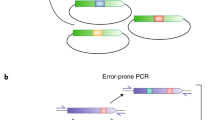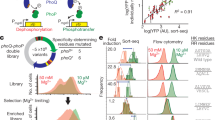Abstract
DNA family shuffling of 26 protease genes was used to create a library of chimeric proteases that was screened for four distinct enzymatic properties. Multiple clones were identified that were significantly improved over any of the parental enzymes for each individual property. Family shuffling, also known as molecular breeding, efficiently created all of the combinations of parental properties, producing a great diversity of property combinations in the progeny enzymes. Thus, molecular breeding, like classical breeding, is a powerful tool for recombining existing diversity to tailor biological systems for multiple functional parameters.
This is a preview of subscription content, access via your institution
Access options
Subscribe to this journal
Receive 12 print issues and online access
$209.00 per year
only $17.42 per issue
Buy this article
- Purchase on Springer Link
- Instant access to full article PDF
Prices may be subject to local taxes which are calculated during checkout





Similar content being viewed by others
References
Darwin, C. On the origin of species by means of natural selection, or the preservation of favoured races in the struggle for life (John Murray, London; 1859).
Mann, C.C. Crop scientists seek a new revolution. Science 283, 310–314 (1999).
Muller, H.J. The relation of recombination to mutational advance. Mutat. Res. 1, 2–9 (1964 ).
Crow, J.F. The odds of losing at genetic roulette. Nature 397, 293–294 (1999).
Wells, J.A. & Estell, D.A. Subtilisin—an enzyme designed to be engineered. TIBS 13, 291– 297 (1988).
Carter, P., Nilsson, B., Burnier, J.P., Burdick, D. & Wells, J.A. Engineering subtilisin BPN' for site-specific proteolysis. Proteins 6, 240 –248 (1989).
Pantoliano, M.W. et al. Large increases in general stability for subtilisin BPN' through incremental changes in the free energy of unfolding. Biochemistry 28, 7205–7213 ( 1989).
Bott, R. et al. in Enzyme engineering XI Vol. 672 (eds Clark, D.S. & Estell, D.A.) (The New York Academy of Sciences, New York; 1992).
Graycar, T.P. et al. in Enzyme engineering XI Vol. 672 (eds Clark, D.S. & Estell, D.A.) 71–79 (The New York Academy of Sciences, New York; 1992).
Hastrup, S. et al. Mutated subtilisin genes. PCT Patent Appl. WO 8906279 (Novo Industries, Denmark; 1989).
Mansfeld, J. et al. Extreme stabilization of a thermolysin-like protease by an engineered disulfide bond. J. Biol. Chem. 272, 11152 –11156 (1997).
Bryan, P.N. et al. Proteases of enhanced stability: characterization of a thermostable variant of subtilisin. Proteins 1, 326– 334 (1986).
Cunningham, B.C. & Wells, J.A. Improvement in the alkaline stability of subtilisin using an efficient random mutagenesis and screening procedure. Protein Eng. 1, 319–325 (1987).
Kuchner, O. & Arnold, F.H. Directed evolution of enzyme catalysts. Trends Biotechnol. 15, 523– 530 (1997).
Tange, T., Taguchi, S., Kojima, S., Miura, K. & Momose, H. Improvement of a useful enzyme (subtilisin BPN') by an experimental evolution system. Appl. Microbiol. Biotechnol. 41, 239–244 (1994).
Kano, H., Taguchi, S. & Momose, H. Cold adaptation of a mesophilic serine protease, subtilisin, by in vitro random mutagenesis. Appl. Microbiol. Biotechnol. 47, 46–51 (1997).
Patkar, S. et al. Effect of mutations in Candida antarctica B lipase. Chem. Phys. Lipids 93, 95–101 (1998).
Shoichet, B.K., Baase, W.A., Kuroki, R. & Matthews, B.W. A relationship between protein stability and protein function. Proc. Natl. Acad. Sci. USA 92, 452–456 ( 1995).
Crameri, A., Raillard, S.-A., Bermudez, E. & Stemmer, W.P.C. DNA shuffling of a family of genes from diverse species accelerates directed evolution. Nature 391, 288– 291 (1998).
Stemmer, W.P. Rapid evolution of a protein in vitro by DNA shuffling. Nature 370, 389–391 ( 1994).
Stemmer, W.P. DNA shuffling by random fragmentation and reassembly: in vitro recombination for molecular evolution. Proc. Natl. Acad. Sci. USA 91, 10747–10751 (1994).
Bott, R. & Betzel, C. Subtilisin enzymes (Plenum Press, New York; 1996).
Rao, M.B., Tanksale, A.M., Ghatge, M.S. & Deshpande, V.V. Molecular and biotechnological aspects of microbial proteases. Microbiol. Mol. Biol. Rev. 62, 597– 635 (1998).
Siezen, R.J., de Vos, W.M., Leunissen, J.A.M. & Dijkstra, B.W. Homology modelling and protein engineering strategy of subtilases, the family of subtilisin-like serine proteases. Protein Eng. 4 , 719–737 (1991).
Harwood, C.R. & Cutting, S.M. Molecular biological methods for Bacillus (John Wiley & Sons, Chichester, UK; 1990 ).
Russel, A.J. & Fersht, A.R. Rational modification of enzyme catalysis by engineering surface charge. Nature 328 , 496–500 (1987).
Beebe, A.M., Mauze, S., Schork, N.J. & Coffman, R.L. Serial backcross mapping of multiple loci associated with resistance to Leishmania major in mice. Immunity 6, 551– 557 (1997).
Lamb, C.J., Ryals, J.A., Ward, E.R. & Dixon, R.A. Emerging strategies for enhancing crop resistance to microbial pathogens. Bio/Technology 10, 1436–1445 ( 1992).
Hall, B.G., Yokoyama, S. & Calhoun, D.H. Role of cryptic genes in microbial evolution. Mol. Biol. Evol. 1, 109–124 (1983).
Li, W.H. Retention of cryptic genes in microbial populations. Mol. Biol. Evol. 1, 213–219 ( 1984).
Jones, L.J. et al. Quenched BODIPY dye-labeled casein substrates for the assay of protease activity by direct fluorescence measurement. Anal. Biochem. 251, 144–152 (1997).
Naki, D., Paech, C., Granshaw, G. & Schellenberger, V. Selection of a subtilisin-hyperproducing Bacillus in a highly structured environment. Appl. Microbiol. Biotechnol. 49, 290– 294 (1998).
Schellenberger, V. Directed evolution can improve subtilisin-secreting Bacillus strains. ASM News 64, 634–638 (1998).
Acknowledgements
We thank Dr. Titur Kretzschmar for initial amplification of the subtilisin fragments; Andreas Crameri, Steven delCardayre, and Claus Krebber for technical advice; and Sun Ai Raillard for stimulating discussions and comments on the manuscript.
Author information
Authors and Affiliations
Corresponding author
Rights and permissions
About this article
Cite this article
Ness, J., Welch, M., Giver, L. et al. DNA shuffling of subgenomic sequences of subtilisin. Nat Biotechnol 17, 893–896 (1999). https://doi.org/10.1038/12884
Received:
Accepted:
Issue Date:
DOI: https://doi.org/10.1038/12884
This article is cited by
-
Algorithms for optimizing cross-overs in DNA shuffling
BMC Bioinformatics (2012)
-
Improved ethanol production by a xylose-fermenting recombinant yeast strain constructed through a modified genome shuffling method
Biotechnology for Biofuels (2012)
-
A novel subtilase with NaCl-activated and oxidant-stable activity from Virgibacillussp. SK37
BMC Biotechnology (2011)
-
Technologies of directed protein evolution in vivo
Cellular and Molecular Life Sciences (2011)



